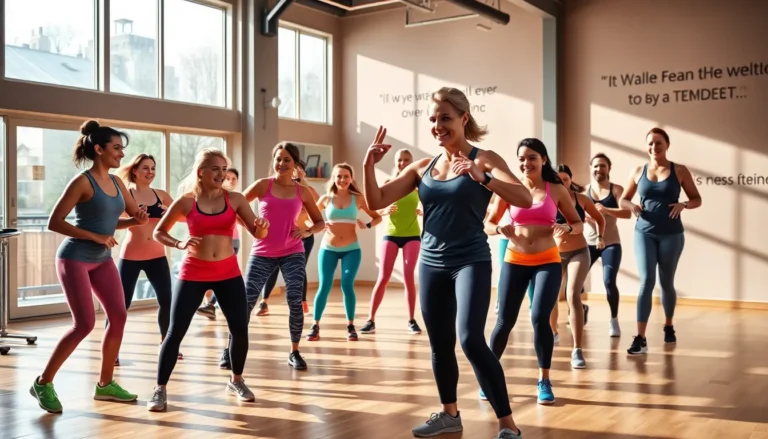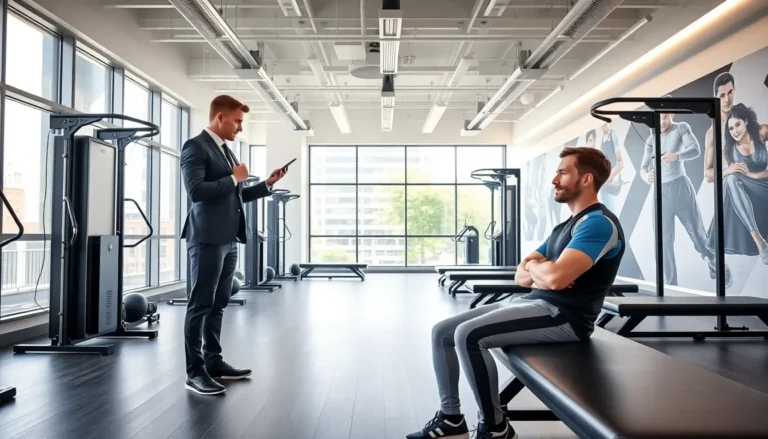Starting a workout routine can feel like trying to solve a Rubik’s Cube blindfolded—confusing and a bit overwhelming. But fear not! This beginner workout guide is here to help anyone navigate the maze of fitness with ease. Whether you’re looking to shed a few pounds or just want to impress your friends with your newfound strength, this guide simplifies everything.
Table of Contents
ToggleWhat Is a Beginner Workout Guide?
A beginner workout guide serves as a structured resource for individuals new to exercise. Its aim is to simplify fitness by providing clear instructions on workouts, suitable for all levels. Specific exercises, cooldown routines, and warm-ups promote safe engagement in physical activity.
Guides typically include a variety of workouts targeting different muscle groups, enhancing overall strength and endurance. They often feature schedules that enable gradual progression. By offering flexibility, users can adapt workouts to fit their own pace and availability.
Health benefits associated with these guides extend beyond physical fitness. They also foster mental well-being, increasing confidence and motivation. Each exercise listed in the guide comes with descriptions on proper form and common mistakes to avoid, ensuring effective practice.
Diet recommendations, alongside workout plans, support balanced nutrition necessary for fitness goals. Users encounter helpful tips on hydration, portion control, and meal timing, contributing to better results. Engaging in a beginner workout routine leads to improved cardiovascular health, increased metabolism, and enhanced muscle coordination.
Support materials such as videos and illustrations often accompany the guide, providing a visual understanding of movements. These resources allow beginners to learn at their own pace, making workouts more approachable. Adjustments for various fitness levels also ensure inclusivity, welcoming everyone on their fitness journey.
Armed with a beginner workout guide, individuals can confidently embark on their exercise routines. They gain access to vital tools that facilitate sustainable habits and promote long-term health. Overall, this guide acts as a stepping stone to a healthier, more active lifestyle.
Benefits of Following a Beginner Workout Guide

A structured beginner workout guide offers significant advantages for those starting their fitness journey. Individuals often experience noteworthy improvements in their fitness levels through consistent engagement in workouts.
Improved Fitness Levels
Strength and endurance increase with regular exercise. According to the American College of Sports Medicine, beginners can expect noticeable gains in stamina within a few weeks of following a structured program. Muscle groups become stronger and more defined when exercises target them effectively. Flexibility enhances through warm-up and cooldown routines that promote overall mobility. As physical skills develop, activities in daily life often become easier, making overall wellness a more attainable goal.
Enhanced Motivation and Confidence
Enhanced motivation and confidence result from following a beginner workout guide. Setting achievable fitness goals creates a sense of accomplishment. As individuals complete workouts, they feel a surge in self-esteem and a commitment to their fitness journey grows. Supportive materials like instructional videos provide clear demonstrations, allowing for better understanding and execution of moves. Group classes or community support also contribute to a positive atmosphere, making it easier to stay consistent. Progress tracking encourages individuals to recognize growth over time, fueling their drive to keep going.
Types of Workouts for Beginners
Beginners can explore various workout types, each targeting specific fitness goals. Understanding these workouts helps establish a balanced routine.
Strength Training
Strength training builds muscle and boosts metabolism. Beginners should focus on bodyweight exercises like squats, push-ups, and lunges. These movements target major muscle groups. Gradually increasing weights or resistance improves strength. Sessions can start with 2-3 times per week, emphasizing proper form to prevent injury. Incorporating core exercises, such as planks, enhances stability and overall performance.
Cardiovascular Exercises
Cardiovascular exercises improve heart health and endurance. Walking, jogging, cycling, and swimming serve as excellent starting points. Engaging in 150 minutes of moderate-intensity cardio weekly supports weight management and energy levels. Beginners can break sessions into manageable chunks, with 10-15 minutes of continuous work. Activities like dancing or group classes also make cardio fun and social, encouraging consistency.
Flexibility and Mobility Workouts
Flexibility and mobility workouts enhance overall physical performance. Stretching exercises, yoga, and Pilates promote body awareness and reduce injury risk. Individuals should aim to incorporate these workouts 2-3 times weekly. Holding stretches for 15-30 seconds improves flexibility over time. Simple movements, such as toe touches and arm circles, are great for beginners to increase range of motion and ease tension in muscles.
Creating Your Beginner Workout Plan
Creating a workout plan involves identifying what works best for individual needs. This plan should incorporate various activities that keep participants engaged while promoting overall fitness.
Setting Realistic Goals
Setting realistic goals is crucial for success. Start by identifying clear, attainable objectives, like exercising three times a week. Goals should prioritize gradual progress in strength or endurance rather than dramatic improvements overnight. Tracking achievements encourages ongoing motivation, while adjusting goals helps individuals stay focused. For example, someone might aim to complete a 5K in three months or increase their push-up count each week. Recognizing these milestones contributes to a sense of accomplishment, fostering commitment to the fitness journey.
Choosing the Right Activities
Selecting suitable activities is key to maintaining interest in a workout regime. Focus on a mix of strength, cardio, and flexibility exercises that align with personal preferences. Bodyweight exercises, like squats and lunges, serve well for beginners, enhancing strength without requiring equipment. Engaging in activities such as brisk walking, cycling, or dancing promotes cardiovascular health while offering enjoyment. Incorporating flexibility exercises, including yoga or stretching routines, aids in recovery and reduces injury risk. When individuals choose activities they enjoy, they’re more likely to stick with their workout plans, leading to long-term health benefits.
Tips for Staying Committed
Commitment to a workout routine can remain challenging. Implementing effective strategies makes adherence simpler.
Tracking Your Progress
Tracking progress serves as a powerful motivator. Keeping a journal or using apps helps individuals record workouts, noting repetitions, weights, and durations. Visualizing progress through charts demonstrates improvements over time. Celebrating small victories, like achieving a personal best, enhances motivation and encourages consistency. Setting specific benchmarks, such as increasing weights or running distances, brings focus to workouts. Regularly evaluating progress provides essential feedback, showing areas for further growth and adjustment in routines.
Finding a Workout Buddy
Finding a workout buddy significantly boosts accountability. Sharing fitness goals with a partner encourages regular attendance and commitment to schedules. Collective workout sessions make exercising enjoyable, creating supportive environments for both parties. Establishing goals together fosters motivation, ensuring partners encourage each other during tough moments. Mutual support also opens up opportunities for trying new exercises, broadening fitness experiences. Scheduling sessions together reinforces the importance of consistency, leading to improved results for both individuals on their fitness journeys.
Starting a fitness journey can be both exciting and challenging. With a well-structured beginner workout guide individuals can embark on this path with confidence. By focusing on gradual progression and incorporating a variety of exercises they can build strength and improve endurance while enjoying the process.
Emphasizing mental well-being alongside physical fitness ensures a holistic approach. Setting realistic goals and tracking progress not only boosts motivation but also fosters a sense of accomplishment. Engaging in enjoyable activities makes it easier to stick to a routine and create lasting habits.
Ultimately this guide equips beginners with the essential tools needed for a healthier lifestyle. With the right mindset and support anyone can transform their fitness journey into a fulfilling experience.








